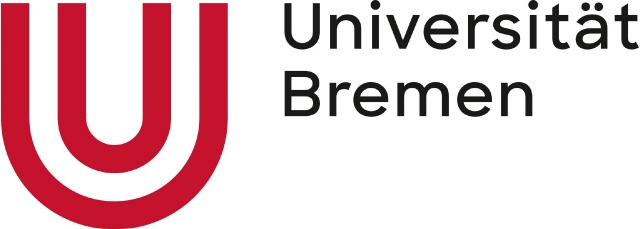Fields of Research at the IUP
Physics and Chemistry of the Atmosphere
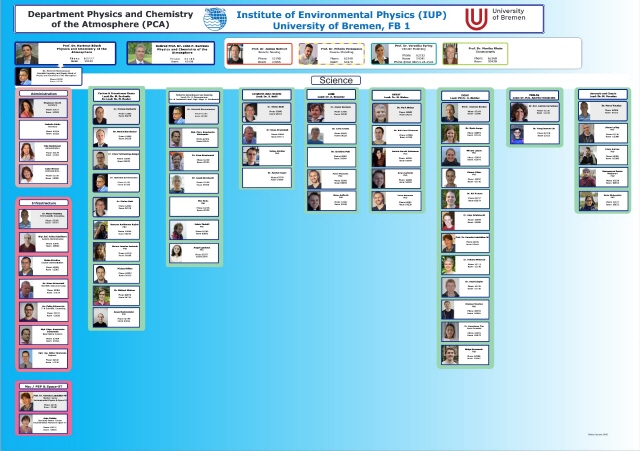
The section of physics and chemistry of the atmosphere is composed of several science teams. Research topics include measurements of trace gases and aerosols by remote sensing and in-situ observations, radiative transfer modelling, laboratory spectroscopy, and scientific support of atmospheric satellite missions. The structure of the whole section can be seen from the following diagram: [3.563 KB]
Research Teams:
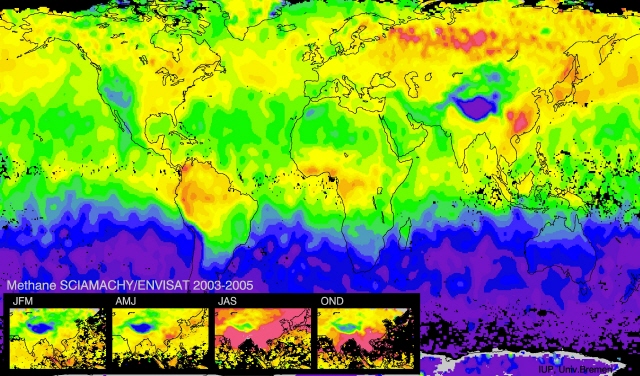
- Carbon gas research: The focus of the IUP Carbon GHG Group is to retrieve information on atmospheric carbon gases (focus: CO2, CH4, CO) from satellites such as SCIAMACHY and aircraft instruments such as MAMAP and to interprete the observations,e.g., in terms of surface sources and sinks (emissions and uptake). The IUP CarbonGroup is involved in a number of national, European and international projects. For example, IUP leads the ESA Climate Change Initiative (CCI) project GHG-CCI. The IUP CarbonGroup is also involved in specifying future satellites such as CarbonSat.

- Aerosol and cloud research: Main topic of this group is the investigation of global optical and microphysical parameters of clouds and aerosols from space.

- The DOAS (Differential Optical Absorption Spectroscopy) group is focusing on the use of the DOAS method to retrieve atmospheric trace gas concentrations from UV/visible spectra of scattered sunlight. The method is applied to data from satellite instruments such as GOME, SCIAMACHY, OMI and TROPOMI, to aircraft measurements, and to the data from the BREDOM network of ground-based UV/visible instruments. Scientific topics covered include air pollution from nitrogen oxides and VOCs, the role of halogen oxides in troposphere and stratosphere, and the development and validation of new satellite data products.
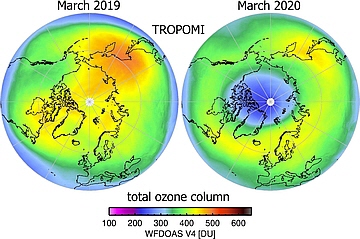
- Research focus of the UVSAT (UV Satellite Data and Science Group) are ozone measurements in the UV spectral range from satellites. We investigate advanced retrieval methods of different data products, including ozone columns, ozone vertical profiles and tropospheric ozone. Scientific goals are trend analyses ("recovery of the ozone layer", "air pollution"), the interaction between ozone and climate, and ozone losses in polar regions ("ozone hole"). Another focus are investigations of solar variability from UV to near infrared from satellite measurements. Our work mainly bases on data recieved from the satellite instruments GOME (Global Ozone Monitoring Experiment, 1995-2011), SCIAMACHY (SCanning ImAging spectroMeter for Atmospheric CHartographY, 2002-2012), GOME-2 (from 2007), OMPS (Ozone Mapping and Profiler Suite, from 2012), and TROPOMI (from 2017).
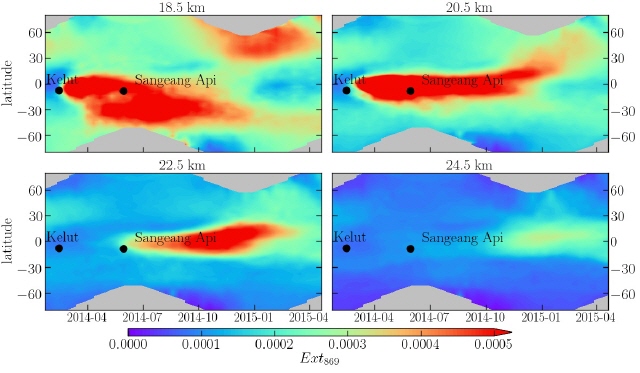
- Limb Retrieval and Radiative Transfer (LRRT) group focuses its activities on the retrieval of the vertical distributions of atmospheric species (O3, NO2, BrO, H2O) and stratospheric aerosol characteristics (extinction, particle size disribution) from space borne measurements of the scattered solar light in UV-Visible-NIR-SWIR spectral range. Measurements from SCIAMACHY and OMPS-LP instruments are mainly used. Furthermore, we continue developing the SCIATRAN radiative transfer model.
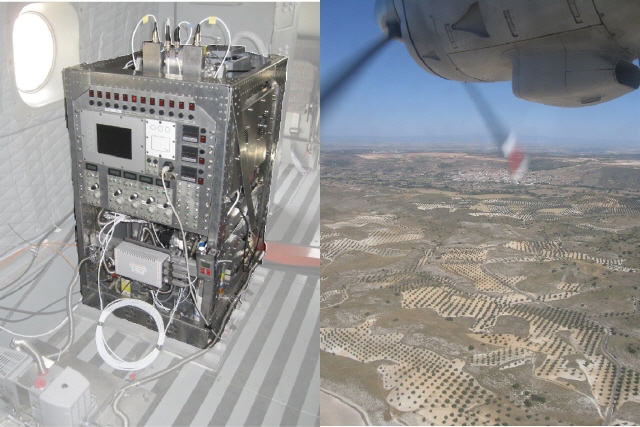
- TROLAS : The activities of the TROLAS group (Tropospheric Radical Observations and Laser Absorption Spectroscopy) of the Institute of Environmental Physics of the University of Bremen (IUP-UB) focus on the investigation of different aspects of the atmospheric chemistry which are closely related to the photochemistry and the mechanisms of free radical reactions involved in the formation and depletion of O3 in the troposphere.
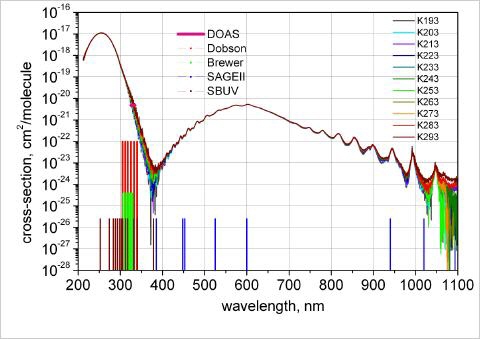
- Molecular Spectroscopy and Chemical Kinetics: Our work is to provide accurate reference data for atmospheric remote sensing, to study molecular physics and chemistry related to atmospheric problems, and to determine atmospheric concentrations by optical methods.
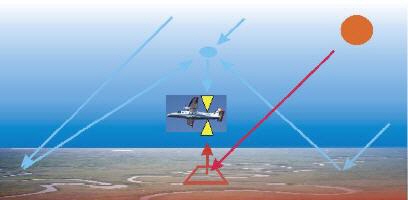
- Electronics Optics & Sensors Group: The main areas are electronics and optics specialties as well as design and test of airborne and balloonborne sensors and components. With MaMAP, a new airborne 2 channel NIR-SWIR grating spectrometer system for simultaneous remote measurements of tropospheric methane (CH4), carbon dioxide (CO2) and oxygen (O2) was introduced.
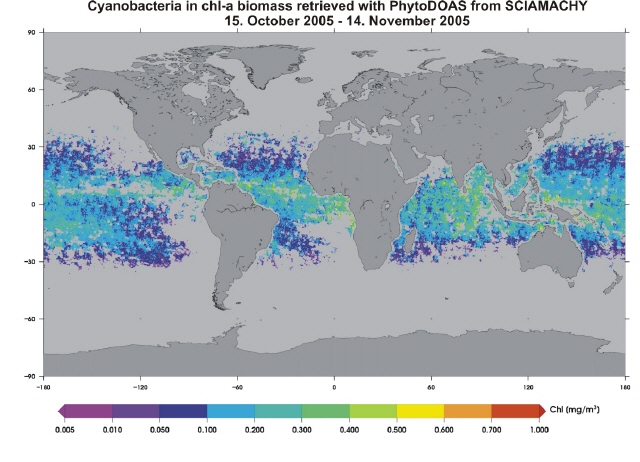
- Phytooptics, a cooperation between AWI Climate Sciences and IUP, studies to the retrieval of new biooptical information from the European satellite SCIAMACHY in addition to using the data of the common ocean color sensors MERIS, SeaWiFS and MODIS. Besides remote sensing retrievals, biooptical and biochemical in-situ parameters of phytoplankton and light conditions are measured and models are used to calculate radiative transfer and primary production.
Satellite Projects of the IUP Bremen:

- CarbonSat: In order to perform global measurements of CO2 and CH4 after SCIAMACHY we are working on the specification of a new greenhouse gas satellite mission: Carbon Monitoring Satellite – CarbonSat.
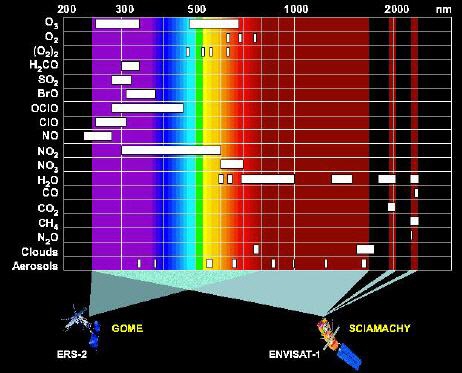
- SCIAMACHY (Scanning Imaging Absorption Spectrometer for Atmospheric CHartographY) is a spectrometer designed to measure sunlight, transmitted, reflected and scattered by the earth atmosphere or surface in the ultraviolet, visible and near infrared wavelength region (240 - 2380 nm) at moderate spectral resolution (0,2 - 1,5 nm). It was launched 2002 as part of the ENVISAT payload. The SCIAMACHY Mission ended April 2012 due to a general failure of ENVISAT.

- GOME (Global Ozone Monitoring Experiment) is a nadir viewing UV/VIS spectrometer aboard the ERS-2 satellite. The scientific projects at IUP encompass: radiative transfer modelling, retrieval algorithm development, validation of GOME data products, and scientific case studies. The whole GOME data can now be found at one place. The GOME Mission ended July 2011.
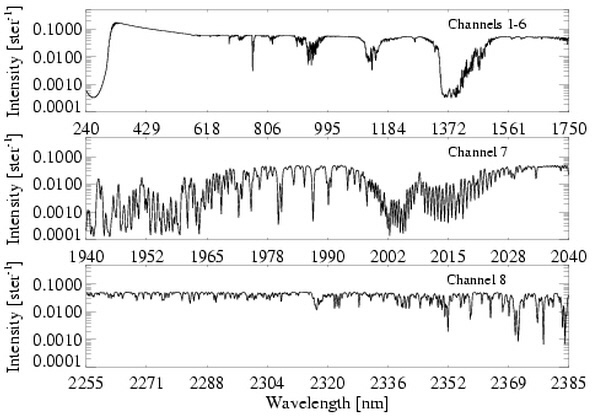
- SCIATRAN The radiative transfer program has been designed to allow fast and accurate simulation of radiance spectra as measured from space with the passive remote sensing UV-Vis-NIR spectrometers SCIAMACHY and GOME. The software package incorporates a radiative transfer model and retrieval algorithms which can be adapted to solve a wide range of scientific tasks.
Director:
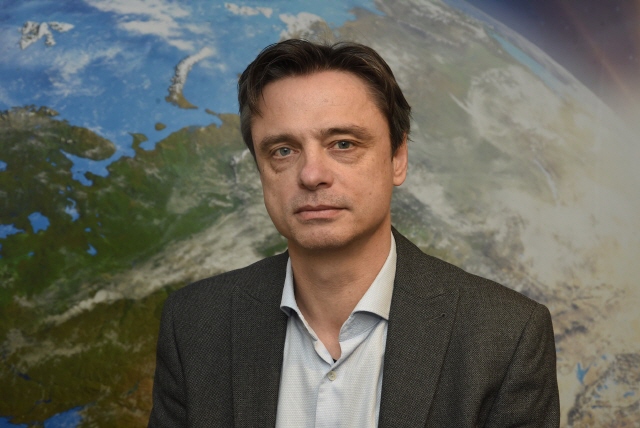
The field of research of "Physics and Chemistry of the Atmosphere" is directed by Prof. Hartmut Bösch.
